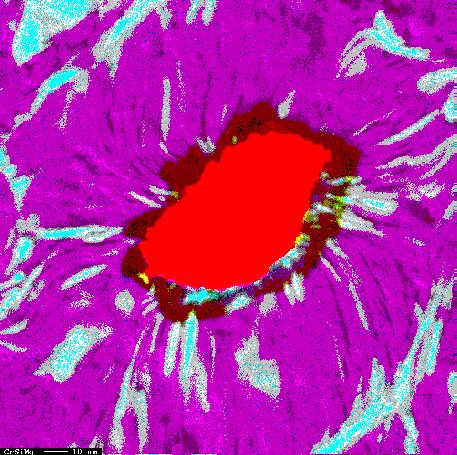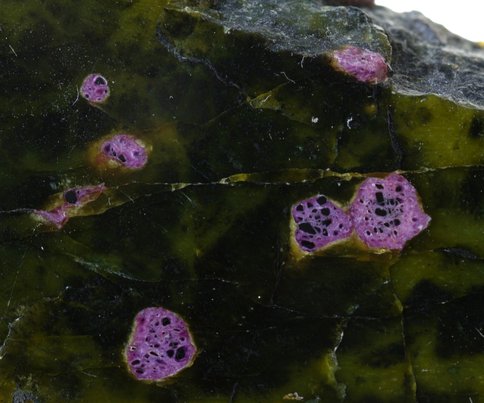2009 Annual Science Report
 University of Hawaii, Manoa
Reporting | JUL 2008 – AUG 2009
University of Hawaii, Manoa
Reporting | JUL 2008 – AUG 2009
Rare Subduction Zone Carbonate Mineral May Hold Clues to Early Life
Project Summary
Recent work performed by Erik Melchiorre as part of a NASA Minority
Institution Research Sabbatical indicates that the rare purple mineral
stichtite Mg6Cr2[(OH)16|CO3] . 4H2O may provide a record of
the carbon, hydrogen and ocygen isotope values of serpentizing fluids
from ancient subduction zones. This could be of significant interest
in the study of methane signatures on Mars, as well as the study of
early life on Earth.
Project Progress
Recent work performed by Erik Melchiorre as part of a NASA Minority Institution Research Sabbatical indicates that the rare purple mineral stichtite (Fig. 1) Mg6Cr2[(OH)16|CO3] . 4H2O may provide a record of the carbon, hydrogen and oxygen isotope values of serpentizing fluids from ancient subduction zones. This could be of significant interest in the study of methane signatures on Mars, as well as the study of early life on Earth.
Samples of Stichtite from Cambrian-age (520 My) serpentinite from Tasmania, Australia and Archean-age (3.25 Gy) serpentinite from Barberton, South Africa were examined using a wide array of tools, some of which are only available through the UH NASA Astrobiology Institute. First the samples were subjected to petrographic examination using reflected light and various electron microscopy techniques. Elemental analysis of spinel grains within the stichtite was performed using the electron microprobe facility. This work demonstrated that these stichtite-bearing rocks formed in a subduction zone, and were not abyssal type serpentinites. Other petrographic analysis showed that the stichtite occurs witin a serpentinite matrix, but is also cross-cut by serpentinite veins (Fig 2.) This indicates that stichtite forms during the serpentinization process. This evidence that stichtite forms during the sperpentinization porcess within subduction zones is contrary to most other divalent cation carbonate occurences that form from weathering in the shallow sub-surface of the Earth. Element mapping using the electron microprobe also revealed that stichtite from both localities contains up to 50% by volume of another visually identical purple mineral, Cr-Clinachlore (Fig 3).
If stichtite is a product of these subduction zone-related fluids reacting with chromite-rich ultramafic rock, then the carbon, hydrogen and oxygen isotope values of the stichtite are likely to record the isotopic composition of this serpentizing fluid. This may include the methane produced during serpentinization (H from serpentinization of ultramafics, C from subducted carbonates). Thus the Barberton stichtite may record the isotopic composition of the subduction zone serpentinizing fluid from the Archean. Carbon isotope values of the stichtite samples were measured using ion probe instrumentation, under the supervision of the Director of the Keck Cosmochemistry Lab, Gary Huss. Stichtite samples from each locality were measured and found to vary by up to 6 per mil, with one single acicular fiber 20 microns long showing a 3 per mil gradient from one end to the other. This might indicate a rapid stichtite forming event that did not permit isotopic equilibration. Absolute carbon isotope values were measured to be in the range of -20 to -26 per mil (PDB), consistent with whole-rock values using traditional isotope extraction and measurement techniques. These light carbon isotope values for stichtite are consistent with values measured for marine kerogen from the same respective geologic age. Significantly, it was demonstrated that this advanced instrumentation may be used in the characterization of this isotopically inhomogeneous material, and provides access to a level of isotopic detail that is not possible with traditional analyses.
It remains to be resolved if the light “organic” carbon signature of stichtite results from the incorporation or carbon from subducted oceanic crust, or from Archea microbes that have recently been shown to live within serpentinite mud volcanoes. Followup work will focus upon determination of hydrogen isotope values for stichtite. If subducted carbonates or carbon with a biological signature is the source of light carbon isotope values of stichtite, the hydrogen isotope values are expected to be consistent with an ultramafic rock source from serpentinization. If carbon is sourced or modified from Archea living within serpentinite mud volcanoes, it is expected that the hydrogen isotope values will also reflect biological fractionation. Regardless of the exact source, there is clearly enough evidence of a possible record of early life to warrant further investigation.
The importance of this work extends beyond the record of early life on Earth. Much work has recently focused on methane emissions from Mars, and determination of the biological or abiological origin of this signal remains an important research vector. This work on stichtite now seeks to establish if abiological processes such as serpentinization and subduction significantly alter a pre-existing biological signal from source materials.
Stichtite nodules (purple) within serpentinite (green) matrix. The dark grains within the stichtite are chromite spinel.

Electron microprobe color composite Cr-Si-Mg elemental map, showing a chromite spinel grain (red) reacting to form stichtite (purpoe) and Cr-clinochlore (grey to light blue).
Electron microprobe elemental maps of (a) chromium (b) silicon© magnesium and (d) a color composite of Cr-Si-Mg showing chromite spinel as red, stichtite as purple and serpentinite as the light blue vein which clearly cross-cuts stichtite.
Electron microprobe elemental maps of (a) chromium (b) silicon© magnesium and (d) a color composite of Cr-Si-Mg showing chromite spinel as red, stichtite as purple and serpentinite as the light blue vein which clearly cross-cuts stichtite.
Publications
- Elchiorre, E.B., Lopez, A. & Velasquez, C.M. (2010). Stable Isotope Astrobiology at Hispanic Serving Instititions: Si Se Puede! AbSciCon 2010.
-
PROJECT INVESTIGATORS:
-
PROJECT MEMBERS:
Erik Melchiorre
Collaborator
Michael Mottl
Collaborator
Gary Huss
Unspecified Role
-
RELATED OBJECTIVES:
Objective 4.1
Earth's early biosphere.
Objective 4.3
Effects of extraterrestrial events upon the biosphere
Objective 7.1
Biosignatures to be sought in Solar System materials
Objective 7.2
Biosignatures to be sought in nearby planetary systems


